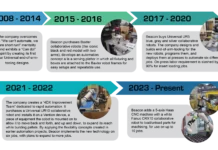Plastics Business
When a highly skilled, highly compensated technician is performing machine setup, it’s best not to interrupt that technician with minor maintenance issues. Interruptions can cause errors to be introduced, as well as adding both time and cost to the bottom line. That’s the premise Tom Boyd, president of Blow Molded Specialties in Pawtucket, Rhode Island, was working with when he encouraged Process Engineer Alex Soto, with support from Lead Process Technician Vinny Cordeiro, to train employees to perform routine maintenance. Other benefits – such as increased facility awareness and an improved culture – followed.
“We were trying to make our setup technicians as efficient as possible, and we knew there were other people in our facility who could be involved in the machinery in a lesser role,” said Boyd. “These people could learn to do preventative maintenance or make certain equipment adjustments, which would keep our technicians focused on the more complicated jobs.” A TPM (Total Productive Maintenance) certification program would accomplish that goal, while also allowing company employees to advance in their careers.
Soto created the curriculum, and Boyd says there’s no magic involved. “You have to figure out what you want the people to know, and then adapt and adjust as you work people through the program,” he explained. At Blow Molded Specialties, a two-hour program introduces the idea of the certification to interested employees, and a basic screening test follows to be sure the employees have a level of knowledge that allows them to successfully enter the program. Employees that qualify are advanced into a four-tier training system.
The first level encompasses systems knowledge, beginning with machinery terminology and an understanding of the systems themselves, including an awareness of the air, cooling tower, pneumatics, hydraulics, etc. Level 1 totals eight hours of instruction over four sessions and is completed in one month. Level 2 delves into machine safety, basic operation and simple maintenance. 5S also is addressed as it relates to the machine, along with further education in terms of downtime and causes so the employees understand how to report issues appropriately. Level 2 is comprised of 20 hours of instruction and takes 8-10 weeks to complete.
Level 3 is hands-on maintenance, plus start-up and adjustment. The employees begin to put their hands on the machines, performing preventative maintenance under the eyes of experienced technicians. There are 40 hours of instruction time in Level 3, and it typically is completed over 3-4 months. Level 4 teaches the employees to make process adjustments, and the final stage of the process encompasses 50 hours of instruction over 4-5 months. The entire program is designed to be completed in one year.
“There’s a test at end of each level,” explained Boyd. “If the employee passes the level, then that employee receives a 50-cent pay increase at the end of each level so by the time the employee passes Level 4, there’s a total of $2 more per hour on his or her paycheck.”
The program at Blow Molded Specialties started at the beginning of 2010. When the results so far are evaluated, Boyd estimates that six hours of technician time is saved each week by each of the Level 4 graduates, along with savings at the other levels, resulting in 23 hours of technician time saved each week.
| Hours of Training | Time Allocated | |
|---|---|---|
| Level 1 | 8 hours | 1 month |
| Level 2 | 20 hours | 8-10 weeks |
| Level 3 | 40 hours | 3-4 months |
| Level 4 | 50 hours | 4-5 months |
“Our technicians are tickled by the program,” Boyd explained. “It’s such a frustration for them to have to stop what they’re doing for a minor issue when they’re trying to set up a machine expeditiously. It’s win/win all the way around.”
Other benefits abound. Facility awareness has increased, as well as an increased sense among employees about what the company is trying to accomplish. “When we have our employee meetings, it enables a higher level of communication because awareness on the technical side has been enhanced,” said Boyd. “It also has a significant impact on the culture, there’s no question. It’s really enhanced our team spirit.”




